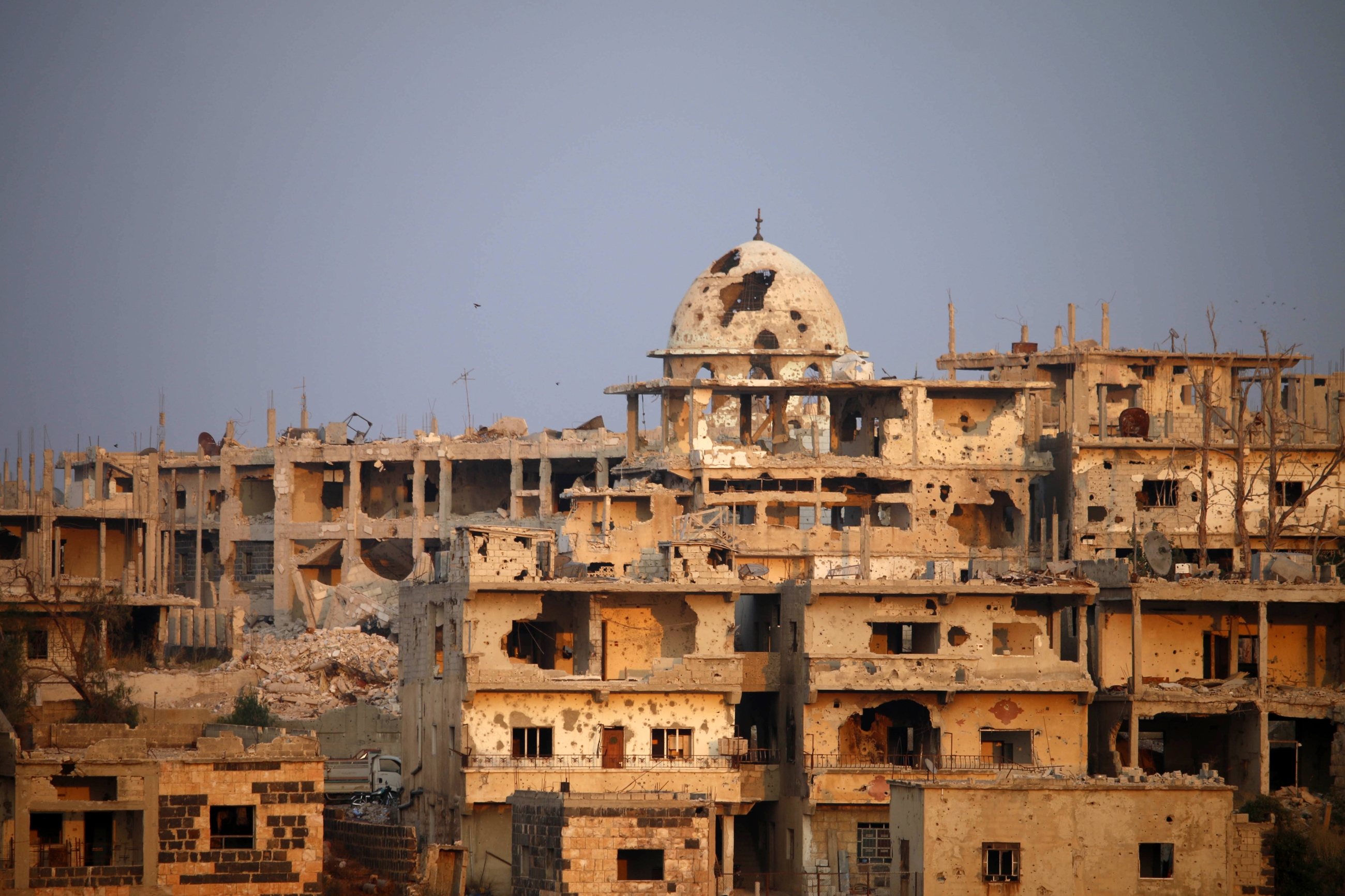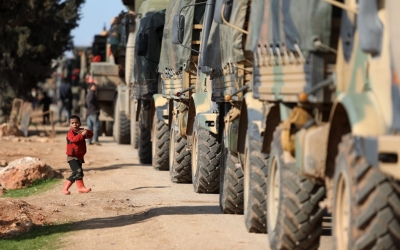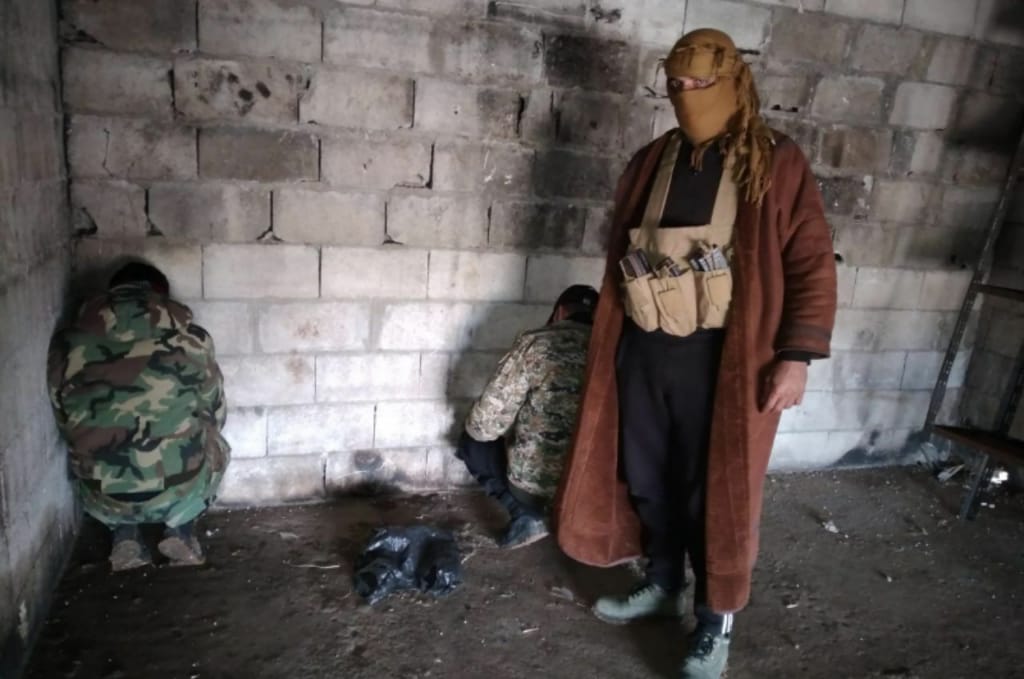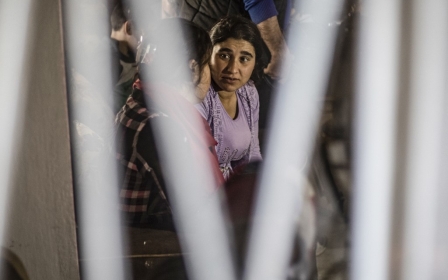Syria rebels transported to Idlib after heavy fighting in Daraa ends

Rebel fighters from Daraa have arrived in northwest Syria as part of a deal with the Syrian government following the heaviest clashes the southwestern province has witnessed in 19 months.
The rebels were taken from Daraa’s city of Al-Sanamayn, the focal point of the fighting, and through the Abu al-Zandin, a crossing located west of Al-Bab in northern Aleppo and separating government forces from Turkish-backed rebels.
New MEE newsletter: Jerusalem Dispatch
Sign up to get the latest insights and analysis on Israel-Palestine, alongside Turkey Unpacked and other MEE newsletters
"We were not subjected to any harassment on the road. We were transported by one bus accompanied by members of the 5th Corps of the government forces," a rebel who had arrived in northern Syria told Middle East Eye.
"We went out with our weapons, but without our families in anticipation of any incidents," the fighter, who called himself Abu Mohammed, said.
Heavy fighting erupted on Saturday when pro-government forces, including members of the Air Force Intelligence, attempted to storm Al-Sanamayn, following a recent increase in tension between the two sides.
Popular demonstrations against the government took place in several areas in the province, most notably in the city of Daraa, in solidarity with Al-Sanamayn.
Tensions developed at an accelerated pace, with systematic rebel attacks on pro-Assad forces and Syrian intelligence checkpoints, placed in different parts of Daraa province.
Photos of rebels detaining intelligence officers and videos of demonstrations near Al-Omari Mosque in Daraa city, the site of the first spark of the Syrian revolution in early 2011, circulated online.
“Government forces tried to enter the city by force, to arrest some of those who were formerly fighting in the ranks of rebel forces,” Adnan al-Shami, a displaced activist from Daraa, told Middle East Eye.
"The city of Al-Sanamayn is not equipped to fight battles. It is located on the old road between Damascus and Daraa, near the ninth division of government forces, and the military hospital.
"The city does not contain any water wells; it will be disastrous if it gets besieged," said Shami, who used a pseudonym for security reasons.
Uneven battle
Seven rebels were killed in the clashes with Assad’s forces, who were attempting to invade Al-Sanamayn with tanks. Three civilians, including a child, were killed as a result of government shelling of populated neighbourhoods.
"We were subjected to a widespread attack, and government forces surrounded Al-Sanamayn with tanks and large numbers of soldiers," Abu Mohammed said.
'We resisted for about 12 hours, as much as our capabilities and our light weapons allow, to prevent the invasion of the city'
- Abu Mohammed, fighter
But after the government stormed the city with tanks, an agreement was reached on Tuesday evening to end the fighting.
"In order to avoid the situation getting worse, government forces offered to negotiate, and it was agreed to leave the city."
The conditions stated that rebels wishing to remain in the city have to sign a settlement agreement with the government, according to the UK-based Syrian Observatory for Human Rights.
The settlement process took place in a secondary school in Al-Sanamayn. The fighters were asked to bring two personal photos to complete the procedure, which is usually marred by many violations.
The settlement or reconciliation process in Syria is meant to guarantee that rebels will not be subject to pursuit by the government, nor detained, in exchange for handing their weapons over to the Syrian intelligence.
Rigged reconciliation
The settlement process guarantees that fighters, medical and relief workers, activists and those wanted by the Syrian intelligence accept to live under state rule again.
They are given a paper stating that they have “settled their status” with the government, and they should not be detained at military checkpoints and by intelligence forces.
This process has been applied in many areas retaken by government forces, especially in the country’s south and centre. Most of the fighters who complete the settlement usually join the 5th Corps, an all-volunteer force that is part of the Syrian army.
The 5th Corps, also called Fifth Legion, is an infantry that fights on Syria’s major front lines.
In February, at least 33 fighters from Daraa were killed fighting alongside the government during its offensive against the rebel stronghold in Idlib province, northwest of Syria, according to the Daraa Martyrs Documentation Office, a non-governmental organisation.
On the other side, 11 rebels from Daraa were killed in the Idlib province while fighting against government forces, according to Mohammed al-Shara, a member of the Daraa martyrs office.
Government forces captured Daraa province in mid-2018, after the government and armed groups signed a settlement agreement and rebels surrendered their heavy weapons.
It is not the first time that Daraa province has experienced tension between government forces and rebels since 2018, but the latest escalation has been the most violent.
Special status
Unlike all areas retaken by pro-Assad forces, the numbers of people displaced from Daraa to northern Syria were limited.
Most of the opposition fighters remained in Daraa after settling their status, alongside a large number of rebels who did not sign the settlement or surrender their weapons, which gave Daraa a special status among areas under government control.
Since last June, there have been 323 attacks, including explosions and clashes, which have resulted in the death of 212 people, more than 150 of them are affiliated with or linked to pro-Assad forces, according to the Observatory.
The attacks usually come as revenge operations after government forces violate the settlement agreement, with civilians or former fighters getting detained by the Syrian intelligence or at checkpoints.
Shara told MEE that the government has not fulfilled its obligations of releasing detainees, some of whom have been imprisoned since 2011, and of returning dismissed employees to their work.
“The settlement document no longer works, as government forces often accuse former rebels and opponents with thefts and other crimes as a pretext for detaining them,” he said.
"The entire province of Daraa is witnessing a security chaos."
The Syrian intelligence has killed at least 14,000 people under torture since 2011 and 130,000 are still detained or forcibly disappeared, according to the Syrian Network for Human Rights, a UK-based NGO.
Middle East Eye delivers independent and unrivalled coverage and analysis of the Middle East, North Africa and beyond. To learn more about republishing this content and the associated fees, please fill out this form. More about MEE can be found here.







